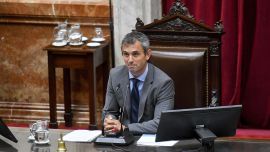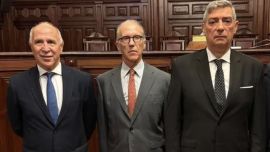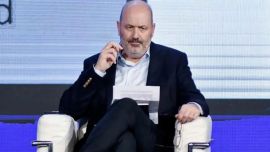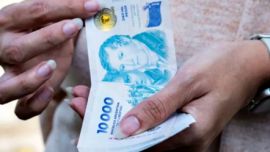Proof is the backbone of the trial investigating the brutal killing of 18-year-old Fernando Báez Sosa, the law student murdered in the entrance of a Villa Gesell nightclub three years ago. After 15 hearings and the testimony of 87 witnesses, only the sentence of the TOC (Tribunal Oral en lo Criminal) 1 court remains.
On January 25, trial prosecutors Juan Manuel Dávila and Gustavo García called for the eight defendants to be sentenced to life imprisonment, requesting afterwards that the judges “will resolve according to the evidence they have observed.” But what exactly is that evidence?
The central discussion lies precisely in the evidence collected during the investigative stage and presented in the four weeks of trial, crucial for the judges ahead of next Monday’s verdict.
The prosecutors are convinced that Máximo Thomsen (age 23), Enzo Comelli (22), Matías Benicelli (23), Blas Cinalli (21), Ayrton Viollaz (23), Luciano Pertossi (21), Ciro Pertossi (22) and Lucas Pertossi (23) acted with premeditation, even planning “how to start the attack.”
“Everybody did everything,” said Dávila when presenting the case for the prosecution.
According to García, the other prosecutor, “two or more people agreed to kill” Báez Sosa and “chose that way, with multiple punches and kicks, above all to the head.”
Fernando Burlando, the lawyer for the plaintiffs, agrees with that line, assuring that “they acted as a bloc, as a unit. Each defendant made his contribution, either hitting out or forming part of that impenetrable human circle.”
Videos and witnesses
The theory of a plan is sustained by the filming of the attack on mobile phone and street CCTV cameras, as well as the accounts from others who were with Fernando on the night he died.
According to witnesses, the group of eight rugby-players entered into an argument with the victim and his 10 friends inside Le Brique. The reconstruction indicates that the uproar that ensued obliged the bouncers to throw out both groups.
“Near the bar there were three guys out of their skulls. I was distracted and suddenly received three punches from one of them,” Tomás D’Alessandro, one of the friends of the victim, recalled during the trial.
Julián García acknowledged being punched inside the club while Lucas Begide recalled Fernando saying to him: “Somebody hit Julián in the face and he wanted to separate them.”
Some minutes later, the accused exited via a side door, even though they didn’t want to.One of the videos shows Máximo Thomsen tussling with a bouncer. In contrast, Báez Sosa and his friends leave by the main door where they again cross paths with the gang in the street.
The youths with the victim thought that the matter was concluded, recalling that Fernando was eating an ice cream when seven minutes later, the gang returned. Lucas Pertossi registered the beginning of the attack with his mobile telephone. In the video, the victim is seen being hit from both the back and front, falling to his knees.
Juan Bautista Besuzzo identified Enzo Comelli as one of the attackers, saying that he saw how he punched Fernando. Ditto for Máximo Thomsen: “He kicked him three times in the jaw.”
“I said ‘please stop’ and they hit me to remove me from the scene,” added Lucas Filardi.
Federico Tavarozzi was one of the witnesses who introduced the theory of the plan: “They arranged everything so that some were attacking while others were stopping outsiders. When these were off the scene, they were free to do what they liked with Fernando.”
The friends of the victim located six of the eight defendants in the lethal attack against Fernando: Enzo Comelli, Máximo Thomsen, Lucas and Luciano Pertossi, Matías Benicelli and Ayrton Viollaz. But a video recorded from the opposite pavement and verified by Federal Police forensic experts identifies all eight by face and clothing. This also forms part of the main evidence.
A sketch, exhibited during the trial, shows Fernando Báez Sosa in the middle surrounded by the indicted. In the inner circle, closest to the victim, appear Thomsen, Cinalli, Luciano and Ciro Pertossi, Enzo Comelli and Blas Cinalli with Matías Benicelli and Lucas Pertossi lagging a bit behind and further away still Alejo Milanesi, who was acquitted at the investigative stage, and another individual, the so-called ‘11th rugby-player,’ who was never indicted.
DNA
The forensic studies of the clothing and sneakers of Benicelli, Ciro and Luciano Pertossi and Máximo Thomsen detected blood belonging to the victim. Another forensic study confirmed genetic traces of Blas Cinalli in the left little finger of Fernando Báez Sosa.
Thomsen’s trainers, for example, had two of Fernando’s bloodstains in the right one and one in the left. Testing by the Federal Police’s Mar del Plata scientific and forensic lab matched marks on the victim’s face with the same footwear. The autopsy report also detailed the shoe’s imprint on the victim’s body.
“I never saw anything like it,” said Diego Duarte, a doctor and forensic expert, at the trial describing: “Not one single but multiple injuries.” The victim suffered damage throughout the central nervous system.
The defendants, apart from asking Fernando’s parents for pardon, declared that they had no intention of killing him.
“I got into a fight because I saw one person against many. They punched me in the face and I reacted by kicking back, I don’t know against whom or how. I’m sure of at least two kicks but I never had any intention of killing anybody,” said Thomsen.
Defence lawyer Hugo Tomei said when presenting his case that the actions attributed to the rugby-players “have not been proven,” assuring that the prosecutors “were proving something else.” He did not deny the crime but asked that it not be categorised as premeditated homicide but rather as “manslaughter committed during a brawl” carrying a sentence of two to six years in prison.
The submissions
Prosecution
Prosecutors Juan Manuel Dávila and Gustavo García argued that there was a deliberate plan to kill and have called for all eight defendants to be sentenced to life imprisonment. “The attack lasted 45 seconds,” they said, giving the assailants seven minutes to agree to killing the youth and hatch their plan. The “premeditation” – according to the prosecutors – was evidenced by their agreeing to kill rather than their going out that night planning to kill somebody..
Plaintiff
Fernando Burlando, representing the parents of the victim, agrees with the theory of a plan and the request for life imprisonment for all eight defendants since “they all” had the “will to kill” and planned “a manhunt” with “the image of Fernando on his knees begging for mercy justifying neither more nor less than the request for life imprisonment for the accused,” he told the TOC1 court in Dolores in his submission. Burlando “completely”endorsed the case for the prosecution, pointing out that Fernando “was the object” of a “manhunt.”
Defence
Hugo Tomei has denied there was any plan: “They say that within seven minutes of leaving the nightclub, they had agreed on a plan. False, unlikely and hardly consistent. There never was any plan to kill.” The lawyer understood that his clients should be acquitted because of the “incongruence” between the original indictment and the accusations made by the prosecutors, asking that should they be convicted, the offence should be defined as “manslaughter committed during a brawl” carrying a sentence of two to six years in prison.



















Comments